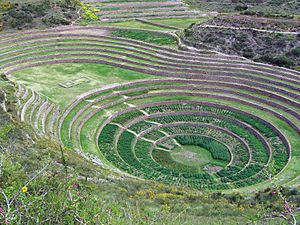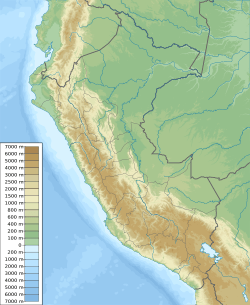Moray (Inca ruin) facts for kids
|
Muray
|
|

The Incan terraces at Moray
|
|
| Location | Peru |
|---|---|
| Region | Cusco Region |
| Coordinates | 13°19′45″S 72°11′44″W / 13.32917°S 72.19556°W |
| History | |
| Cultures | Inca |
Moray (also called Muray in the Quechua language) is an amazing ancient site in Peru. It's about 50 kilometers (31 miles) northwest of the city of Cuzco. You'll find it on a high plateau, about 3,500 meters (11,500 feet) above sea level. It's just west of a small village called Maras.
This site holds special Inca ruins. The most famous parts are several circular, terraced depressions. Imagine giant bowls carved into the earth! The biggest one is about 30 meters (98 feet) deep. Like many other Inca sites, Moray also had a clever system to bring water to the crops.
People aren't completely sure why the Incas built these unique depressions. However, their design and how they face the sun and wind create something special. There can be a temperature difference of up to 5°C (9°F) between the top and the bottom of the terraces. This means different parts of the same "bowl" could have different climates.
Contents
Why Moray Was Important for Farming
Many experts believe Moray was used for farming experiments. The Incas were very smart farmers! Soil samples taken from the terraces show something interesting. They found that soils from different regions were brought to Moray. This suggests the Incas were testing which soils worked best for different crops.
Creating Microclimates
The wide temperature differences between the terrace levels created what we call "microclimates." Think of it like a natural greenhouse! Each level could have had slightly different conditions. This allowed the Incas to grow many types of plants. They could grow crops that needed warmer weather at the bottom. Crops that liked cooler temperatures could grow at the top.
How the Incas Built It
Some people think Moray might have looked like an open pit mine at first. After the mining was done, the Incas could have made the walls stronger. This would have stopped landslides. Then, they started to grow crops on the terraces. This shows how clever and resourceful the Inca people were.
Protecting Moray from Damage
Moray is an important historical site, but it faces challenges. During the rainy season of 2009–2010, the Department of Cusco had a lot of rain. This was much more rain than usual. Sadly, this heavy rain caused lasting damage to the ruins of Moray.
Damage to the Terraces
The terraced levels are made from stone and packed earth. The huge amount of rainwater washed away the ground under the structures. This caused a lot of damage. In February 2010, the eastern side of the main circular terrace collapsed. This made people worried about the future of Moray. It is a very popular place for tourists.
Repair Efforts
To stop more collapse, a temporary wooden support was put in place. This was done until bigger repair work could begin. Repairing Moray is a big job. It needs a lot of money and the yearly heavy rainfall makes it harder. People are working to restore the site to how it looked originally. It's important to protect Moray so people can keep visiting and learning from this amazing Inca site for many years to come.
See also
 In Spanish: Moray (sitio arqueológico) para niños
In Spanish: Moray (sitio arqueológico) para niños


